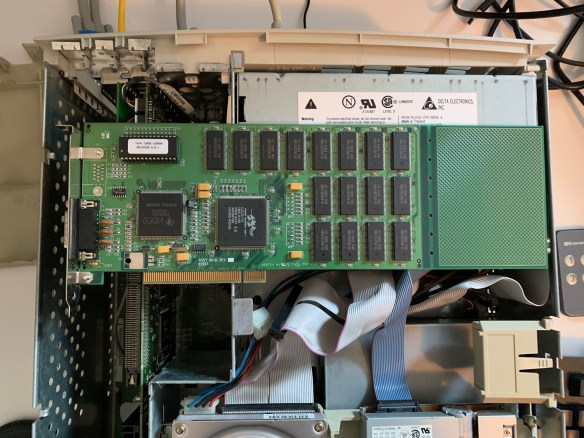So, I learned something recently: if you pick up your iPhone with eBay open on an auction bid screen in just the right way, you may accidentally click the bid button and end up buying an old computer. Totally not the worst thing ever, and certainly a creative way to make a decision.
So, not too long later, a box arrives!
In the 1990s, Apple created some pretty “interesting” computers and product line. One thing you could get is a DOS Compatibility (or PC Compatibility) card. This was a card that went into one of the expansion slots on a Mac and had something really curious on it: most of the guts of a PC.
Others have written on these cards too: https://www.engadget.com/2009-12-10-before-there-was-boot-camp-there-were-dos-compatibility-cards.html and http://www.edibleapple.com/2009/12/09/blast-from-the-past-a-look-back-at-apples-dos-compatibility-cards/. There’s also the Service Manual https://tim.id.au/laptops/apple/misc/pc_compatibility_card.pdf with some interesting details.
The machine I’d bought was an Apple Power Macintosh 7200/120 with the PC Compatible card added afterwards (so it doesn’t have the PC Compatible label on the front like some models ended up getting).

Wikipedia has a good article on the line, noting that it was first released in August 1995, and fitting for the era, was sold as about 14 million other model numbers (okay not quite that bad, it was only a total of four model numbers for essentially the same machine). This specific model, the 7200/120 was introduced on April 22nd, 1996, and the original web page describing it from Apple is on the wayback machine.
For older Macs, Low End Mac is a good resource, and there’s a page on the 7200, and amazingly Apple still has the tech specs on their web site!
The 7200 series replaced the 7100, which was one of the original PowerPC based Macs. The big changes are using the industry standard PCI bus for its three expansion slots rather than NuBus. Rather surprisingly, NuBus was not Apple specific, but you could not call it widely adopted by successful manufacturers. Apple first used NuBus in the 1987 Macintosh II.
The PCI bus was standardized in 1992, and it’s almost certain that a successor to it is in the computer you’re using to read this. It really quite caught on as an industry standard.
The processor of the machine is a PowerPC 601. The PowerPC was an effort of IBM, Apple, and Motorola (the AIM Alliance) to create a class of processors for personal computers based on IBM’s POWER Architecture. The PowerPC 601 was the first of these processors, initially used by Apple in its Power Macintosh range. The machine I have has one running at a whopping 120Mhz. There continued to be PowerPC chips for a number of years, and IBM continued making POWER processors even after that. However, you are almost certainly not using a PowerPC derived processor in the computer you’re using to read this.
The PC Compatibility card has on it a full on legit Pentium 100 processor, and hardware for doing VGA graphics, a Sound Blaster 16 and the other things you’d usually expect of a PC from 1996. Since it’s on a PCI card though, it’s a bit different than a PC of the era. It doesn’t have any expansion slots of its own, and in fact uses up one of the three PCI slots in the Mac. It also doesn’t have its own floppy drive, or hard drive. There’s software on the Mac that will let the PC card use the Mac’s floppy drive, and part of the Mac’s hard drive for the PC!
The Pentium 100 was the first mass produced superscalar processor. You are quite likely to be using a computer with a processor related to the Pentium to read this, unless you’re using a phone or tablet, or one of the very latest Macs; in which case you’re using an ARM based processor. You likely have more ARM processors in your life than you have socks.
Basically, this computer is a bit of a hodge-podge of historical technology, some of which ended up being successful, and other things less so.
Let’s have a look inside!
So, one of the PCI slots has a Vertex Twin Turbo 128M8A video card in it. There is not much about this card on the internet. There’s a photo of one on Wikimedia Commons though. I’ll have to investigate more.
Does it work though? Yes! Here it is on my desk:

Even with Microsoft Internet Explorer 4.0 that came with MacOS 8.6, you can find some places on the internet you can fetch files from, at a not too bad speed even!

More fun times with this machine to come!





Pingback: Adventures in the Apple Partition Map (Part 2 of the continuing adventures with the Apple Power Macintosh 7200/120 PC Compatible) | Ramblings